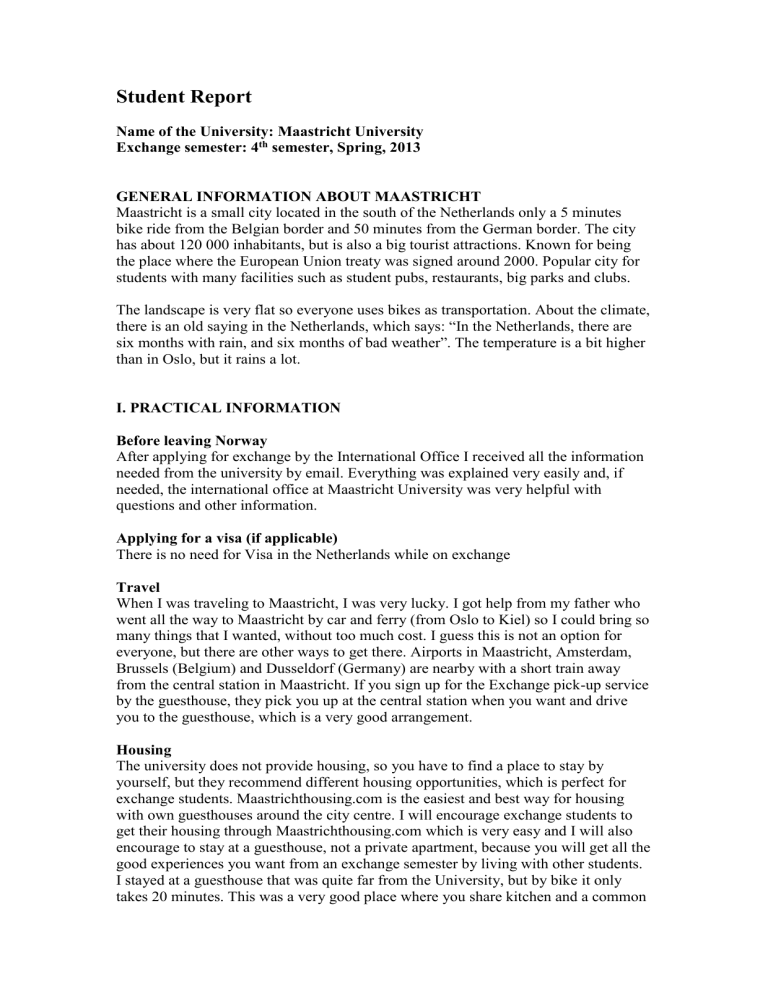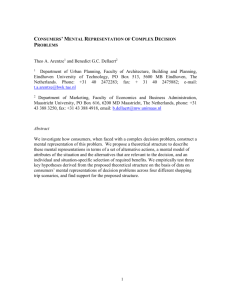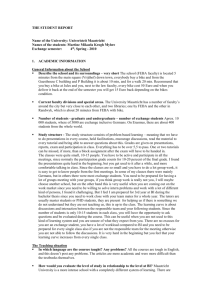Student Report

Student Report
Name of the University: Maastricht University
Exchange semester: 4 th semester, Spring, 2013
GENERAL INFORMATION ABOUT MAASTRICHT
Maastricht is a small city located in the south of the Netherlands only a 5 minutes bike ride from the Belgian border and 50 minutes from the German border. The city has about 120 000 inhabitants, but is also a big tourist attractions. Known for being the place where the European Union treaty was signed around 2000. Popular city for students with many facilities such as student pubs, restaurants, big parks and clubs.
The landscape is very flat so everyone uses bikes as transportation. About the climate, there is an old saying in the Netherlands, which says: “In the Netherlands, there are six months with rain, and six months of bad weather”. The temperature is a bit higher than in Oslo, but it rains a lot.
I. PRACTICAL INFORMATION
Before leaving Norway
After applying for exchange by the International Office I received all the information needed from the university by email. Everything was explained very easily and, if needed, the international office at Maastricht University was very helpful with questions and other information.
Applying for a visa (if applicable)
There is no need for Visa in the Netherlands while on exchange
Travel
When I was traveling to Maastricht, I was very lucky. I got help from my father who went all the way to Maastricht by car and ferry (from Oslo to Kiel) so I could bring so many things that I wanted, without too much cost. I guess this is not an option for everyone, but there are other ways to get there. Airports in Maastricht, Amsterdam,
Brussels (Belgium) and Dusseldorf (Germany) are nearby with a short train away from the central station in Maastricht. If you sign up for the Exchange pick-up service by the guesthouse, they pick you up at the central station when you want and drive you to the guesthouse, which is a very good arrangement.
Housing
The university does not provide housing, so you have to find a place to stay by yourself, but they recommend different housing opportunities, which is perfect for exchange students. Maastrichthousing.com is the easiest and best way for housing with own guesthouses around the city centre. I will encourage exchange students to get their housing through Maastrichthousing.com which is very easy and I will also encourage to stay at a guesthouse, not a private apartment, because you will get all the good experiences you want from an exchange semester by living with other students.
I stayed at a guesthouse that was quite far from the University, but by bike it only takes 20 minutes. This was a very good place where you share kitchen and a common
area with other exchange students, but you have your private toilet, shower and bedroom. Most exchange students stayed at the Main Guesthouse in the city centre, but from my perspective it seems the same. So, find a guesthouse with other exchange students provided through Maastrichthousing.com. This will give you the best exchange experience!
Costs
An approximation of the monthly cost of my exchange semester
Rent NOK 3400
Books
Food
NOK 500
NOK 2500
Transport NOK 0
Other NOK 2000
Total NOK 8 400
You can find a very nice place for low rent. 3400 each month is one of the cheapest rents you can find though. When it comes to books this depends very much on the courses you are taking. You buy the books at the start of each period that is 2 times each semester. Some courses don’t require books, just articles found online, while some courses require several books that might cost up to 1500 NOK per course.
Books can usually be bought at the Study Store next to the university, but be quick, they get sold more quickly than you know. Food is also generally cheaper in the
Netherlands and a normal budget for food can come to around 2500 NOK.
When you come to Maastricht, be sure to get a bike. You can either rent from the
Guesthouse or buy privately. Bike is essential in getting yourself around in
Maastricht, and with the flat terrain makes it perfect for biking around. This also minimizes your transportation cost.
Other costs, such as sports, going out, hobbies is usually very cheap, off course depends on in what way you practice this. If you want to travel to other countries or nearby European cities, such as Amsterdam, Paris, Brussels, Cologne, this is not more than a 2-4 hour train ride away and doesn’t cost that much.
Culture and language
I didn’t experience any problems with language on the faculty or with other students.
As long as you can practice an advanced level of English, it is usually no problem with communication. The culture in the Netherlands is not that different from the
Norwegian culture so it is not a big change from what you are used to. The tutorials and lectures are held in English.
Cultural and social effects from the exchange experience
I think that this exchange semester has helped me very much with managing myself on my own in a bigger scale than before. I think it also will make me better to cooperate with people in social settings and in a work situation. I think the experience might give me better opportunities in the future career since I have experience in managing myself in new and different environments and adapt to different problems and situations.
II. ABOUT THE SCHOOL
Maastricht University is a relatively big university in the Netherlands, which is spread around the city centre of Maastricht. The School of Business and Economics (SBE) is a new faculty at the university and has approximately 15 000 students where about
50% of these are foreign students and about 20% exchange students. Maastricht
University uses what they call Problem Based Learning (PBL), which they rate very high and are very proud of as a learning system. This system has a more practical and active approach to solving problems. They use tutorials, which are mandatory to attend, containing 10-15 students in addition to lectures as we are used to from BI.
The Lectures are usually not mandatory and not as important as the tutorials. In the tutorials, the students discuss the required learning goals for the tutorial, so you need to be well prepared to join the discussion. The tutor in the class evaluates your participation in the class discussions so it is essential to prepare to get a decent grade.
The PBL system can be very hard and require a lot of work compared to BI. All the tutorials are mandatory as well, with few exceptions.
Course registration
You can register for courses before your arrival in Maastricht and you should also do this. The deadline for course registration for the first period in the spring semester is around 01. December, this changes every year. I registered without any problems. All information about the courses is available in the Course Database at the Maastricht
University Home Internet Page. This works very well, you just sign up and if you sign up before the deadline, participation is promised. If you not are satisfied with the course, you can change the course to another one during the first or two first weeks, depends on the course.
Academic calendar
Just as at BI, the year is divided into two semesters. But at Maastricht University, the semesters are again divided into 3 periods each, in total 6 periods each year. In the two first periods in each semester you can have one or two courses where the learning consists of the PBL system. These periods consist of 7 weeks with learning and week number 8 is the exam week. The last periods of each semester is called the skills period and consists of only one skills course which is very practical, but give you less credit, but only lasts for two weeks.
I arrived the 27 th
of January, which was about a week before the school started so it was good to have a few days to get settled. Also, in the week before the semester and the first week of the semester is there an introduction week hosted by the exchange network called ESN (Erasmus Student Network) which is a great way to get to know the city, and get to know other exchange students. This was very fun and is a great opportunity you cannot miss. The ESN is also responsible for the pick-up service and also arrange city tours during these two weeks. The ESN also hosts different trips and several parties during the week. After just one week of the semester, it is a national holiday in the Netherlands, which is the Carnival. This is a holiday, which is very big in Maastricht. Everyone dresses up in different costumes, goes out and watches parades and have fun. This was a great memory and one of the best weeks of the semester.
Arrival date:
First day of the semester:
Last day of classes:
27. January 2013
04. February 2013
28. June 2013
Examination period: 1-5 April, 3-7 June
Any special events/holidays: Carnival 11-17
February
Other:
Arrival
A few days before semester start, there was two introduction days for exchange students with more practical information about the University. The administration was well prepared for my arrival and had arranged for current students to show us around campus and tell us everything we needed to know. They also gave us a view of how the PBL sessions works so we could be better prepared.
The International Office
At the SBE, there is an international office, which is very helpful, and only nice people work there. Every time I went there, they gladly helped me with everything that I wondered. They speak perfectly English.
Social activities
As I mentioned earlier, there is a student organization for exchange students called
ESN, that hosts weekly parties and other events such as city tours, birthday parties, trips etc. Native students can also join these activities. ESN helps you to get to know the other students and the parties are very fun. The best party is something they call
Cantus. It is sort of a beer festival with singing and drinking. But be aware of that there are not many tickets and they tend so sell out very quickly.
III. ACADEMICS
In the classroom
Maastricht University uses, as mentioned, the PBL system as teaching style, This style of teaching contains tutorials where students discuss and debate issues, tasks, problems in their subject. The tutorial is controlled by a tutor with a better educational background than the students and helps out when explanation is needed. All the tutorials are held in English. The tutor evaluates the student’s contribution to the discussion in the tutorial. So a participation grade will be a part of the final grade.
You need to get a decent participation grade to pass the course. To be able to contribute to the discussion, you need to be very well prepared, and this requires a lot of studying and sometimes very advanced literature. Compared to BI the workload is a lot more at Maastricht University and much of the content is at a higher level of study than at BI as well.
From what I have heard, Maastricht University School of Business and Economics is a very high rated university in Europe, and this is why it attracts a lot of international students. Many of these students are very serious about their education and don’t care about other students in the tutorials. In one of my classes this semester, a lot of the students where international and started arguing a lot because they wanted to show of
themselves for the tutor to get a high participation grade and a better final grade. This was very new to me and it was very difficult to discuss with these students. I think it made the academic return lower.
Besides all the heavy tutorials, the professors and tutors used a lot of group work in form of presentations and group papers, which could make the workload extremely heavy sometimes.
Lectures were also used, but were not mandatory and didn’t explain anything more than what was discussed in the tutorials and also what was the required literature for the tutorials.
Course materials
Books where mostly used as course material, but each course had its own Internet page with other required articles and presentations to prepare before the tutorials. The books were the primary material used in most of the courses, with the online articles and papers as smaller parts of the subject.
Exams
The exams were based on the course material discussed in the tutorials. Normally, in many courses, the exam was around 60% of the final grade, participation was around
20% and a project/paper and/or presentation was the last 20% of the final grade. In order to pass the course, all of these evaluations needed to be more than a grade of 5.5 to pass. When it comes to class attendance, you can only be absent two times or you fail the class.
The grading system is different at Maastricht University from BI. The scale goes from
1-10 with a final grade of more than 5.5 to pass the course. The participation, group work and final exam also have to be more then 5.5 individually to pass the course. To get a 9 or a 10 it has to be completely perfect, and a lot of teachers have never given a
10 before. I would say that it takes a lot more work at Maastricht University to get the same grade as at BI.
Library and technology
I spent a lot of time at the library during my exchange semester and was very happy with it. Good access to use literature, copy machines, computers, group rooms, computer labs and also a very helpful staff with a good cafeteria. My only complain could be that even though there were computers to use around campus, there were not very many and almost always taken. The level of technology used in teaching or distributing information was at the same level as BI.
Description of courses
Course code & name Master/
Bachelor
EBC2116 Dynamic
Exam form
Bachelor 3-hour written
Modelling and
Dynamic
Optimization exam
EBC2050 Project and
Production
Management
EBC2029
Understanding Society
EBS2039 Spread sheets
Bachelor Final Paper
Bachelor 3-hour written exam
EBC1030
International
Economic Relations
Bachelor 3-hour multiplechoice exam.
100 multiple choice questions in only 3 hours
Bachelor Final
Assignment
Prerequisites Approved as
Good knowledge of differential equations and a an advanced level of mathematics
None
Some basic statistic knowledge
Basic microeconomi c and macroeconomi c knowledge
None
Comments
Other experiences
Get a bicycle as fast as possible. You can buy a second-hand bike for around
50 Euros or rent a perfect (almost new) bike from the guesthouse for around
150 Euros. I rented my bike, which is a lot more expensive, but I never had a single problem with it. This was good when all my other friends had problems
Very hard and complicate d. Not very popular among the native students either
Not very difficult.
Introductor y course
Very interesting.
Medium level of difficulty.
Very interesting and useful.
Very big workload.
Very heavy project and exam.
Very useful! Not very difficult almost once a week with their bike.
Also get a solid lock for your bike. Bikes get easily stolen.
Find a nice guesthouse with many other students, I would recommend the main guesthouse and the guesthouses at Volksplein and Vijverdalseweg
(where I lived) as the best options to get the best exchange experience.
Get tickets for the cantus, they get sold out very fast and it is the best party of the semester
Be aware of that the University is tough; so don’t underestimate the level of difficulty.
The Carnival in Maastricht and the Queen’s day in Amsterdam are a great experience and unique festivals you cant find similar in Norway.
And if you like coffee, be aware of that the coffee shops in the Netherlands do not always sell coffee. You may get an unpleasant surprise.
Even though the school was more difficult than I was aware of and sometimes the workload could be more than I could handle, I am very happy and satisfied with my exchange semester in Maastricht. All the new friends you meet and experiences you get have made this a very good semester in a beautiful city.
Feel free to contact me through the International Office at BI if you have any questions or wonder about anything.



